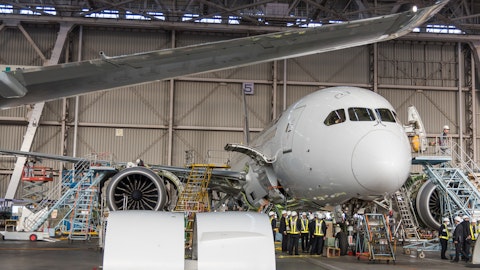Chip Blankenship: So we’ve seen — I think I said this in the last quarterly call as well. We’ve seen an increase in quote activity requests for Woodward to quote components and subsystems and systems for different types of defense vehicles. We’ve seen that activity go up in terms of the number of quotes we get, and we’ve also seen the urgency and the turning of those quotes go faster than in recent times. So not really referring to IRAD, our internal R&D, that’s pretty stable in terms of our platform development. But as far as specific customer requests, we’ve seen that increase and hold steady at an increased rate.
Christopher Glynn: Okay, great. And just taking a look at big picture, you have new management team working on lots of execution and portfolio streamlining. How is everything coming together? I mean, it looks great. But from a cultural perspective, middle-level managers, how is that translating down from the C-suite?
Chip Blankenship: These things always take time, Chris. But what I’ve been really pleased with is the lean transformation activities when we engage a full team of these 30 plus people in value stream analysis. We have — that team includes frontline operators, first-level supervisors. It includes supplier managers, customer service reps, plant — entire VP of Operations, plant managers, and I even participated in one. So we are sort of doing the full-on engagement approach to moving the needle from that focus on reducing lead times and serving customers better and eliminating waste. And so far so good on that. But these things take time, and it will take a multiyear journey to get where we want to go, just to be candid.
Christopher Glynn: Yes. Great. Well, it sounds like you have four very productive processes two under — at each segment underway. Is that something where you develop leaders and muscle memory and you have 8 or 10 of them in ’24 and 15 or 20 in ’25. Is that a reasonable way to think about it?
Chip Blankenship: Yes, sir, you’ve seen this movie before. And each one of these activities before a value stream can qualify to be under transformation, they need to be able to identify 3% of dedicated resources that are going to be with that activity for a year. And so it takes a lot of pre-work. And like you said, we then generate leaders that have been through the process to take on the next one.
Christopher Glynn: Great. Thanks for your explanations.
Chip Blankenship: Thanks much.
Operator: Your next question comes from the line of David Strauss from Barclays. Please state your question.
David Strauss: Thanks. Good afternoon, everyone.
Chip Blankenship: Good afternoon, David.
Bill Lacey: Hey, David.
David Strauss: Chip, you mentioned the headwind that you’ll have on the Aero margin side from higher OE growth. Could you give a little bit more granularity in terms of what you’re forecasting within that 10% to 14% for Aero between OE aftermarket and then maybe just defense bucketed altogether?
Chip Blankenship: Yes. This is the kind of headwind that we really like because from a long-term perspective, we are creating an installed base that will pay back dividends over time. So it’s the kind of headwind we’ll take every time. I don’t think I’m prepared to break down exactly how that works. And really, to some extent, it will play out over time, and we’ll be able to demonstrate our ability to hit those rates and — throughout the whole supply chain. So I’d be premature to say exactly what it is because I really don’t know exactly how it’s going to turn out. But I just want people to know that it’s a good headwind, and that’s something we are going to overcome with margin expansion on both the OE side based on our productivity and investment in getting costs out of those products as well as work in the aftermarket as well as we can.
David Strauss: Okay. And then on guided weapons, it sounds like you’re expecting at the bottom here, but I mean, should we — are you expecting that business to start growing again given what’s going on, like with JDAM and small diameter bomb, would you actually expect that business or do you plan for that business to start growing again?
Chip Blankenship: We don’t really have any expectations of that. And we have no firm information along those lines, but customers have called us and asked us about our capacity and ability to respond and we’ve done our homework with our supply chain to make sure our suppliers can respond. And if it does crank up a higher order rate, then we’ll be ready for that. But as of now, we have no orders to move in that direction.
David Strauss: Okay. And then last one for me, I think, for Bill. It looks like you’re — I can’t tell a guide, but it does look like your free cash flow guide, cash from ops guide for next year includes some sort of working capital headwind, it looks like. Could you just elaborate on what exactly you have assumed from a working capital perspective? Thanks.
Bill Lacey: Yes. In our working capital, we are seeing our inventory — working capital is actually going to be pretty good. Not a — it’s not going to be a heavy impact, David. AR, we will expect to see some of that will be a bit of a challenge there going up as sales go up. And so that will offset some of the other areas and is the headwind that you’re seeing there in working capital.
David Strauss: Okay. Thanks very much.
Bill Lacey: You’re welcome.
Operator: Your next question comes from the line of Gavin Parsons from UBS. Please state your question.
Gavin Parsons: Thanks. Good afternoon.
Chip Blankenship: Good afternoon, Gavin.
Bill Lacey: Hey, Gavin.



